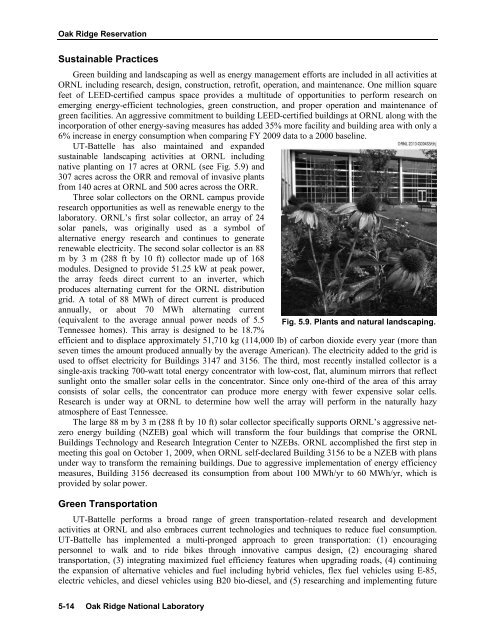DOE/ORO/2327 Oak Ridge Reservation Annual Site Environmental ...
DOE/ORO/2327 Oak Ridge Reservation Annual Site Environmental ...
DOE/ORO/2327 Oak Ridge Reservation Annual Site Environmental ...
You also want an ePaper? Increase the reach of your titles
YUMPU automatically turns print PDFs into web optimized ePapers that Google loves.
<strong>Oak</strong> <strong>Ridge</strong> <strong>Reservation</strong><br />
Sustainable Practices<br />
Green building and landscaping as well as energy management efforts are included in all activities at<br />
ORNL including research, design, construction, retrofit, operation, and maintenance. One million square<br />
feet of LEED-certified campus space provides a multitude of opportunities to perform research on<br />
emerging energy-efficient technologies, green construction, and proper operation and maintenance of<br />
green facilities. An aggressive commitment to building LEED-certified buildings at ORNL along with the<br />
incorporation of other energy-saving measures has added 35% more facility and building area with only a<br />
6% increase in energy consumption when comparing FY 2009 data to a 2000 baseline.<br />
UT-Battelle has also maintained and expanded<br />
sustainable landscaping activities at ORNL including<br />
native planting on 17 acres at ORNL (see Fig. 5.9) and<br />
307 acres across the ORR and removal of invasive plants<br />
from 140 acres at ORNL and 500 acres across the ORR.<br />
Three solar collectors on the ORNL campus provide<br />
research opportunities as well as renewable energy to the<br />
laboratory. ORNL’s first solar collector, an array of 24<br />
solar panels, was originally used as a symbol of<br />
alternative energy research and continues to generate<br />
renewable electricity. The second solar collector is an 88<br />
m by 3 m (288 ft by 10 ft) collector made up of 168<br />
modules. Designed to provide 51.25 kW at peak power,<br />
the array feeds direct current to an inverter, which<br />
produces alternating current for the ORNL distribution<br />
grid. A total of 88 MWh of direct current is produced<br />
annually, or about 70 MWh alternating current<br />
(equivalent to the average annual power needs of 5.5<br />
Tennessee homes). This array is designed to be 18.7%<br />
efficient and to displace approximately 51,710 kg (114,000 lb) of carbon dioxide every year (more than<br />
seven times the amount produced annually by the average American). The electricity added to the grid is<br />
used to offset electricity for Buildings 3147 and 3156. The third, most recently installed collector is a<br />
single-axis tracking 700-watt total energy concentrator with low-cost, flat, aluminum mirrors that reflect<br />
sunlight onto the smaller solar cells in the concentrator. Since only one-third of the area of this array<br />
consists of solar cells, the concentrator can produce more energy with fewer expensive solar cells.<br />
Research is under way at ORNL to determine how well the array will perform in the naturally hazy<br />
atmosphere of East Tennessee.<br />
The large 88 m by 3 m (288 ft by 10 ft) solar collector specifically supports ORNL’s aggressive netzero<br />
energy building (NZEB) goal which will transform the four buildings that comprise the ORNL<br />
Buildings Technology and Research Integration Center to NZEBs. ORNL accomplished the first step in<br />
meeting this goal on October 1, 2009, when ORNL self-declared Building 3156 to be a NZEB with plans<br />
under way to transform the remaining buildings. Due to aggressive implementation of energy efficiency<br />
measures, Building 3156 decreased its consumption from about 100 MWh/yr to 60 MWh/yr, which is<br />
provided by solar power.<br />
Green Transportation<br />
UT-Battelle performs a broad range of green transportation–related research and development<br />
activities at ORNL and also embraces current technologies and techniques to reduce fuel consumption.<br />
UT-Battelle has implemented a multi-pronged approach to green transportation: (1) encouraging<br />
personnel to walk and to ride bikes through innovative campus design, (2) encouraging shared<br />
transportation, (3) integrating maximized fuel efficiency features when upgrading roads, (4) continuing<br />
the expansion of alternative vehicles and fuel including hybrid vehicles, flex fuel vehicles using E-85,<br />
electric vehicles, and diesel vehicles using B20 bio-diesel, and (5) researching and implementing future<br />
5-14 <strong>Oak</strong> <strong>Ridge</strong> National Laboratory<br />
Fig. 5.9. Plants and natural landscaping.











